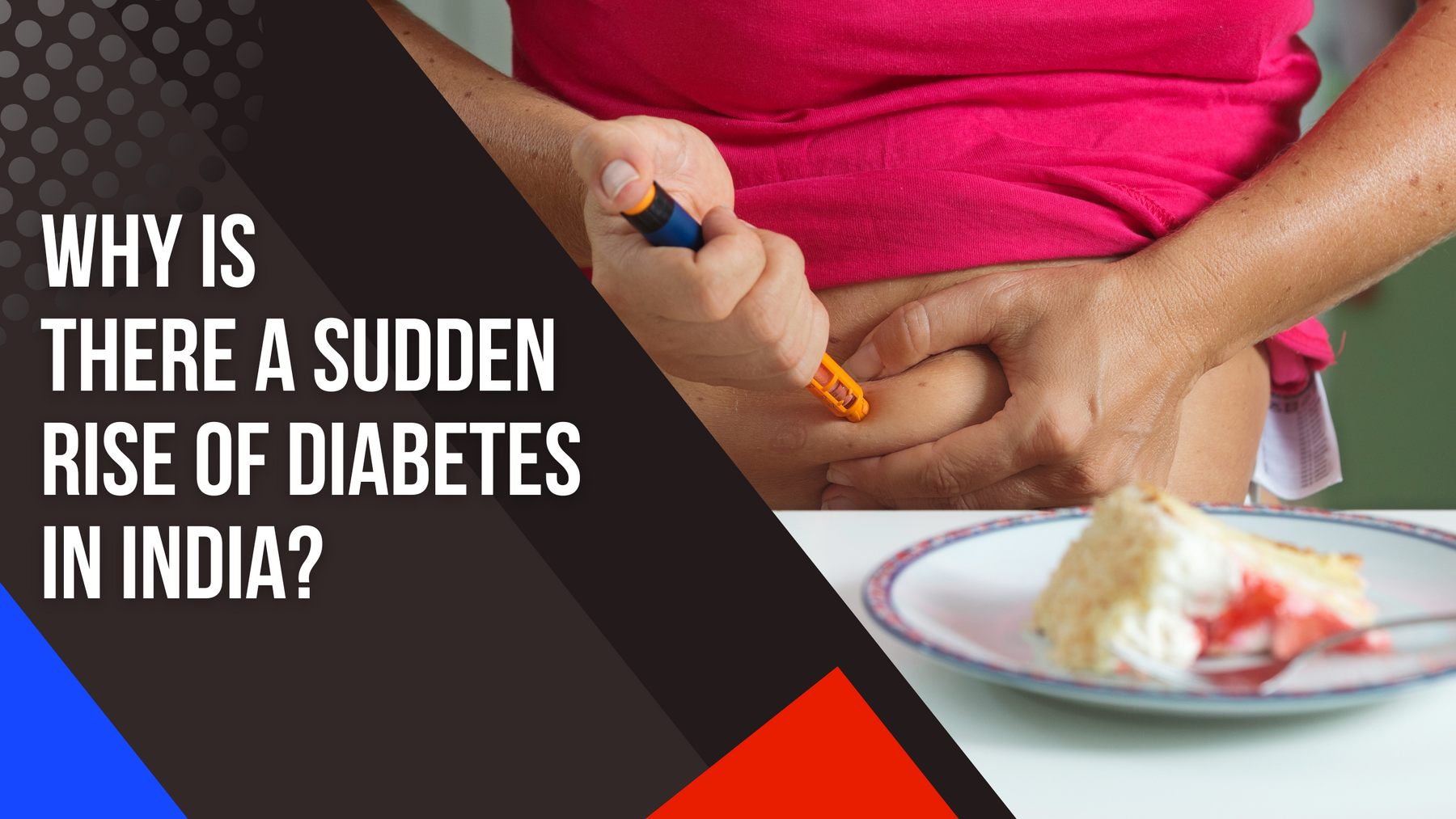
Why is there a sudden rise in Diabetes in India?
Table Of Content
India is famously known as the diabetic capital of the world. According to a May 2019 study, nearly half (47%) of Indians with diabetes are unaware of their condition, and only about a quarter (24%) have control over it.
The stresses we encounter every day have contributed to unhealthy eating choices.

Our frequency of eating, intake of saturated fats, lack of sleep and a sedentary lifestyle, owing to corporate desk jobs have all equally contributed to the rising diabetic epidemic. This is not just in India but throughout the world.
Diabetes is popularly categorised under two big subheadings, type 1 and type 2. Type 1 diabetes, also referred as juvenile diabetes is often diagnosed in childhood and carries little scope for complete reversal. Type 2 diabetes on the other hand is reversible in most cases. Here is a detailed blog explaining the difference:
It begs the question, why has India been witnessing such a sudden rise in diabetes? Let’s slowly delve into it.
What makes India the diabetes capital of the world?
India has become the epicentre of diabetes. The reasons are a multitude. Our for-fathers ate three staple meals a day, but most of us reach out for food atleast five times a day today. Food delivery apps like Zomato saw over 400 million in order volume for the year 2020 itself and the same is expected to touch over 1.6 billion by 2026.

Gone are the days where we were limited to festivals if we had to indulge in junk food. With delivery apps at our finger tips, multi cuisine menu's are open to us anytime we want to feast.
Even restaurants that promote 'healthy' food are really only serving high sodium, high fat meals in the name of health. We recognise terms like 'low- calorie' and 'low- carb', but are moving away from 'high- nutrition' foods that are actually healthy for us.
Especially when it comes to diabetes management, we have made carbs such a villan. When really, carbs, in the form of whole grains and fiber is what will heal our body. Checkout this video to understand more:
A macrobiotic diet, as discussed in the above video is low in animal proteins and fats and infact high in whole grains.
What we should really be fearing is processed grains like white flour, white bread etc. Whole grains like whole wheat, barley, rye, jowar, quinoa, brown rice etc are very crucial for reversal.

But every restaurant menu you open will label these foods "high calorie" and "high carb". Whole grains were what our ancestors ate! If we can just switch our understanding to diabetes "reversal" and not diabetes "management", this point will become clear to us.
Besides our addiction to ordering food from outside, our work habits too have drastically changed.
Ask your grandparents, and they will remind you of a time when they were young. Our grandparents never worked for 16 or even 14 hours a day. They finished work early and went our to socialise in the evenings with their friends. They met in parks and corner shops to spend time and talk to each other.
According to the employment and labour laws of India, 2022, overtime among workers has increased from 50 to 125 hours in some sectors!

Add the entire pandemic scene to the mix and we see that there is no longer a line between professional and private time. We are working in the late night hours, when we should ideally be sleeping, making our circadian cycle worse.
A bad circadian healthy is linked to more insulin resistance, and a rise in diabetes. Our lifestyles are more stressful than ever and the quality of life we are living now is only going downhill.
Sure, most of us have one hour worth of structured physical activity per day, but besides that one hour, all we do is sit. Lifestyle changes is the cornerstone to good health. What does this mean? Watch this to understand more:
Are there specific food habits that we as Indian's have that leads to diabetes? Yes! Here are fantastic articles I wrote to help you understand:
Which city in India has the maximum number of diabetic cases?
India accounts for one in every six (17%) diabetic cases worldwide. According to India State-Level Disease Burden Initiative Diabetes study collaborators, the prevalence and number of diabetics in India increased from 5.5% and 26.0 million in 1990 to 7.7% and 65.0 million in 2016.
In 2016, Tamil Nadu had the highest prevalence, followed by Kerala, Delhi, Punjab, Goa, and Karnataka.
However, According to an analysis of two separate studies conducted by the Indian Council of Medical Research and Sree Chitra Tirunal Institute for Medical Sciences and Technology, Thiruvananthapuram, diabetes affects 19.4% of the population in Kerala, compared to 13.6% and 10% in Chandigarh and Tamil Nadu, respectively.
The rural areas in Tamil Nadu may not have access to the best nutrition and health care. Hence, many of these villagers are living with the condition and are unaware about the same.

Awareness, diagnosis, regular checkups, and other methods of preventing and treating noncommunicable diseases (NCDs), particularly diabetes, are extremely low in rural areas. Such factors are responsible for the condition in Kerala as well.
Which city in India has the Least number of diabetic cases?
According to a recent study by the Indian Council of Medical Research-India Diabetes (ICMR-INDIAB), Bihar has the least cases of diabetes, standing at 4.3%, while Meghalaya in the north-east accounts for 4.5 % of the population.
We have also seen that the rural areas experience lower rates than the urban populace, as seen in Assam, which is 4.4 per cent in rural areas and 12.4 per cent in urban areas.
Similarly, in Meghalaya, 3.5 per cent of diabetes cases are in rural areas and 8.9 per cent in urban areas. This could only just mean access to proper testing facilities.
However, factors like more physical work and manual & agronomic labour to help maintain the insulin sensitivity of the people in these areas, which results in lower cases.
The lifestyle in these areas is physically demanding. In the northeast hilly regions, life is active, and because of the high altitude, the oxygen demand and daily energy expenditure are quite high, which doesn’t allow the body to store fat.
This equated to lowered occurrences of obesity, which in itself is a huge factor cauing diabetes. Life in the rural areas is also less stressful and competitive. There are no traffic jams to trigger stress, nor are people running to their 9-9 jobs.
These factors could also very well contribute to better health and longevity.
Which of our food habits is causing a rise in cases of Diabetes?
According to studies on migrant and native Indians and the epidemic rise of diabetes in India, Indians are predisposed to the disease more than other races.
If your first though was genetics, then you are wrong. Genetics play a very small role when it comes to diabetes. Diabetes is a lifestyle disease, the cause is purely your lifestyle and food choices.
With regard to lifestyle, India is undergoing a rapid epidemiological transition due to increased urbanisation. With regard to diabetes and coronary artery disease, India's current urbanisation rate is 35%, up from 15% in the 1950s. This could significantly impact the country's current and future disease patterns.
There is a dramatic transition from a traditional to a modern lifestyle caused by socioeconomic development over the last 40 to 50 years. This has resulted in diets high in saturated fat, animal products, and dairy. Physical inactivity due to technological advancements only adds to our problems.

All of these factors may have a negative impact on insulin sensitivity and contribute to obesity. The biggest one though, is dairy.
How does dairy consumption contribute to Diabetes?
While most of us blame genetics for diabetes, global studies show otherwise. Many countries have higher rates of diabetes, while some have low rates.
For instance, in Japan, the incidence of diabetes is 18 times more in the United States. But what is surprising is that when Japanese families immigrate to the United States, the risk for diabetes also increase. This study actually compares different countries and shows that there is a strong relations between diabetes and cow's milk consumption.

This in itself shows that lifestyle and eating habits surpass genetics when it comes to someone suffering from the disease.
Milk has a protein names Casein. This has opioid like properties that trigger an autoimmune response that increases the drinkers susceptibility to infections that can eventually cause diabetes.
The immune system then creates its own antibodies to combat this strange animal protein. Surprisingly, the this animal protein closely resembles the beta cells in the pancreas, which are responsible for insulin production.
In an attempt to destroy the animal protein in dairy products, our own antibodies begin attacking their own tissues as well as the beta cells in the pancreas. This process is referred to as immunological or molecular mimicry.
It was also found that bovine insulin was the culprit. It is the cow insulin that triggers insulin autoantibodies (IAAs) that attack the islet cells of the pancreas.

Researchers drew blood from children with type 1 diabetes to see if they had elevated levels of anti-bovine protein antibodies. They were found in the blood of every single child with type 1 diabetes, whereas levels in the control group were significantly lower.
What about Ghee though? Should you stop that too? Watch this to understand more:
You might also want to read this article that specifically talks abotu the adultration of milk in India:
What can we change in our eating habits to avoid diabetes?
When we look at diabetes, we have to see it from three different lenses - Nutrition, lifestyle and physical activity.
As we’ve already covered, nutrition does play a critical role. Adding fibre, whole grain's, fruits and vegetables is crucial. Not only this, but cutting down on saturated fats, animal products and dairy is of utmost importance.
Here is an article compiling essential superfoods that you want to include regularly:
When planning your meals, think of "nutrient rich" and not "low carb" or "low calorie".
Make sure to eat a rainbow of vegetables, thus, ensuring you consume enough vitamins and minerals. These play a crucial role in improving gut health, which in turn helps with improving insulin sensitivity.
Not only what you eat is important, but what TIME you eat is also very important. Make sure to eat your heaviest meals earlier on in the day, tapering overall consumptions as you reach towards sunset.

You also want to limit your meals to 2-3 meals per day. We live in a world of abundance, you will never run out of food to eat. But most of us are so insecure about the idea that we will get hungry soon and reach out for a snack even before we are hungry.
Allow your pancreas time to rest and repair. This is crucial for diabetes reversal. Constantly eating every two hours puts you further at the risk of insulin resistance.
A weekly once water only fast is also a great idea. This needs to be done only under the supervision of a doctor and a nutritionist though. Clients I work with can swear by the benefits of the same and see an improvement in their FBS within a few weeks! Our in- house doctor guides them through the same to make the transition from eating constantly to not eating seamless.
Physical activity is another vital piece to this puzzle. It is recommended to have a total of 150 mins of weekly aerobic activity and pair it with 2-3 sessions of resistance training of some form (astanga yoga, resistant bands workout etc), working out all the major muscle groups.
This keeps individuals insulin sensitive, improves metabolic & mitochondrial health, depletes glycogen reserves, decreases oxidative stress & cortisol levels, improves sleep and keeps hunger to a minimum.
Want Some Motivation? Listen To Our Client's Diabetes Reversal Story.
How is the carb-to-protein-to-fats ratio a dominant factor?
A high fat diet makes the functioning of insulin even more sluggish. Making sure you keep your overall fat intake per day to less than 20% of your daily calories is necessary.
One specific type of fats you want to avoid consuming at all cost is Saturated fats.These are a type of fat that is typically solid at room temperature.

Eggs, meat and dairy (particularly ghee) fall under this category. Certain types of oil's, such as coconut oil's are also saturated fats. There is evidence to suggest that high intake of saturated fats may be associated with an increased risk of developing type 2 diabetes.
Saturated fats clog your cell walls and make it hard for insulin to do its job. Thus, keeping your body in a state of needing more and more insulin to help break down blood glucose.
When the body becomes insulin resistant, it requires more insulin to maintain normal blood sugar levels, and this can lead to a decrease in insulin production over time.
A decrease in insulin production, combined with insulin resistance, can lead to high blood sugar levels and an increased risk of developing type 2 diabetes.
Make sure to consume whole plant fat sources such as nuts and seeds instead. 1-2 tbsp of nuts or seeds, per meal, is more than enough.

You also want to make sure that your protein consumption is minimal. Excess proteins, particularly coming form animal sources, also contains excess growth hormones, cholesterol and saturated fats. All of these contribute to diabetes.
Most of your calories must come from whole plants. They are fiber rich and help keep you free from diabetes. So eat whole grains, pulses, vegetables and fruits.
Why Combining Fats With Carbs Is Detrimental To the Body?
One thing to note here is carbs alone are not the problem here. The combination of processed carbs with fats is more problematic. Let’s think of insulin as more of a shuffler or a transporter of nutrients into our cells via the bloodstream.
Insulin is a cell unlocker. It is the key that unlocks your cells so that food and nutrients can enter. When carbs combine with fats, the fats enter with the glucose into the cells. The fats can block insulin from doing its job.
Fats, if not used for energy with periods of either fasting or physical activities, contributes to insulin resistance and weight gain leading to obesity and, ultimately, diabetes.
A little bit of healthy fats with your food is extremely important. But too much saturated fats is not.
Cells slowly get deprived of nutrition leading to organ damage which results in conditions such as diabetic retinopathy(eye damage), diabetic nephropathy (kidney damage) and so on and so forth. The body loses the ability to use glucose for energy since insulin fails to do its job and the constant presence of floating glucose in the blood becomes dangerous for the body.
Conclusion
Diabetes is a rapidly growing disease throughout the country and the world at large.
Making small, but sustainable lifestyle changes, nutritional changes and adding even a bare minimum amount of physical activity has proven to be beneficial for diabetes management.
Early screening and taking active measures to change your lifestyle, can go a long way in disease management, if not a full reversal.
Sign up below for a free consultation with me to know more.
Let's Just Talk. No Obligations.
I do free consultations every Tuesday's and Thursday's. Either way you will get some actionable tips to reach your fitness goals faster.


Leave a comment